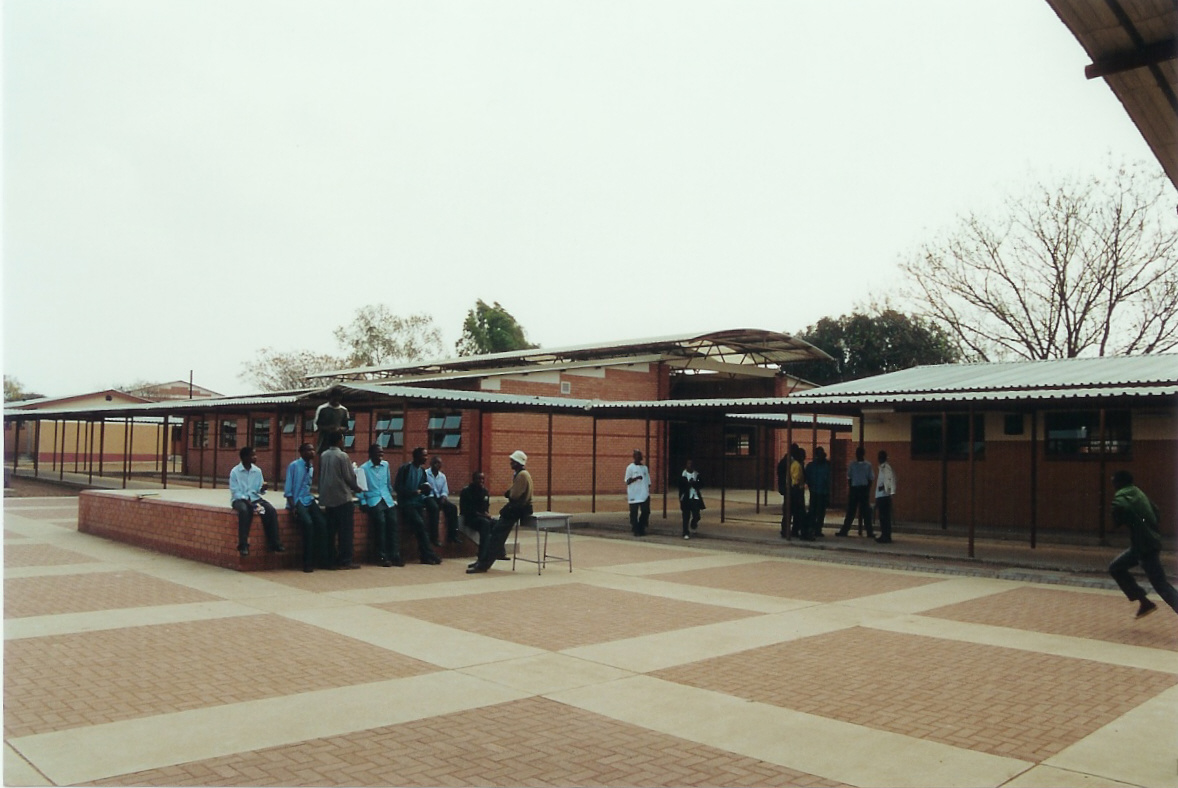|
Scottish Livingstone Hospital
Scottish Livingstone Hospital, also known as Molepolole Hospital, is a government-run district hospital located in Molepolole, Botswana, from Gaborone. History The hospital was built in 1933 by the United Free Church of Scotland. It opened the following year on 3 September, and Dr Sheppard was the first doctor. At the time, the hospital only held 20 beds. Facilities In order to combat the ongoing HIV/AIDS epidemic, the government opened a new hospital building in November 2007. The new building, built by Arup, hosts 350 beds and features high-tech heating and cooling systems. The hospital houses an Infections Disease Care Clinic that offers antiretroviral therapy. Most of the doctors speak only English while the patients speak mostly Setswana. Thus, medical care is usually given through a translator. The number of doctors and amount of medical equipment is limited: There is only one x-ray machine and no radiologist. There are long wait times to see a doctor, and the obstetr ... [...More Info...] [...Related Items...] OR: [Wikipedia] [Google] [Baidu] |
Molepolole
Molepolole is a large village in Kweneng District, Botswana. The people who reside in Molepolole are called Bakwena, who are one of the eight major tribes in Botswana. The Bakwena Kgosi (Chief), Sebele I was among the three chiefs who went to England to seek protection from the British in the colonial era. Molepolole serves as the capital of the Bakwena. It was named after the Molepolole river. It is one of the largest traditional villages in Africa with a population of over 73,102 people as of 2011. It lies 50 kilometres west of the national capital Gaborone and acts as gateway for exploring the Kalahari Desert. It has a large traditional kgotla and the Scottish Livingstone Hospital, is found in Molepolole. History Ntsweng was the capital of Bakwena before they moved to Molepolole. Ntsweng is a historic site located a few kilometers southeast of Molepolole. The area was first occupied by Bakwena, led by Sechele I (ruled 1829–92), in 1864. It was abandoned in 1937 when Ba ... [...More Info...] [...Related Items...] OR: [Wikipedia] [Google] [Baidu] |
Arup Group Limited
Arup (officially Arup Group Limited) is a British multinational professional services firm headquartered in London which provides design, engineering, architecture, planning, and advisory services across every aspect of the built environment. The firm employs approximately 16,000 staff in over 90 offices across 35 countries around the world. Arup has participated in projects in over 160 countries. Arup was originally established in 1946 by Sir Ove Arup as ''Ove N. Arup Consulting Engineers''. Through its involvement in various high-profile projects, such as the Sydney Opera House, Arup became well known for undertaking complex and challenging projects involving the built environment. In 1970, Arup stepped down from actively leading the company, setting out the principles which have continued to guide Arup's activities since in his 'Key Speech'. The ownership of Arup is structured as a trust. The beneficiaries of the trust are Arup's employees, both past and present, who rec ... [...More Info...] [...Related Items...] OR: [Wikipedia] [Google] [Baidu] |
1934 Establishments In Bechuanaland Protectorate
Events January–February * January 1 – The International Telecommunication Union, a specialist agency of the League of Nations, is established. * January 15 – The 8.0 Nepal–Bihar earthquake strikes Nepal and Bihar with a maximum Mercalli intensity of XI (''Extreme''), killing an estimated 6,000–10,700 people. * January 26 – A 10-year German–Polish declaration of non-aggression is signed by Nazi Germany and the Second Polish Republic. * January 30 ** In Nazi Germany, the political power of federal states such as Prussia is substantially abolished, by the "Law on the Reconstruction of the Reich" (''Gesetz über den Neuaufbau des Reiches''). ** Franklin D. Roosevelt, President of the United States, signs the Gold Reserve Act: all gold held in the Federal Reserve is to be surrendered to the United States Department of the Treasury; immediately following, the President raises the statutory gold price from US$20.67 per ounce to $35. * February 6 – French pol ... [...More Info...] [...Related Items...] OR: [Wikipedia] [Google] [Baidu] |
Alfred Merriweather
Alfred Musgrave Merriweather OBE, CBE (19 August 1918 – 8 October 1999) was a Scottish missionary in Botswana, who was a member of the National Assembly of Botswana and its first Speaker. He helped improve public health in Botswana. Biography Merriweather was born in Yorkshire, and lived later in Glasgow. He moved to Molepolole in Bechuanaland Protectorate in 1944 to work in the Scottish Livingstone Hospital. His medical reputation allowed him to become medical adviser to the Seretse Khama, first President of Botswana The president of the Republic of Botswana is the head of state and the head of government of Botswana, as well as the commander-in-chief of the armed forces, according to the Constitution of Botswana. The president is elected to a five-year t .... Merriweather was elected as the speaker of the Legislative Assembly, and as the first speaker of the National Assembly when Botswana became independent. He gained a PhD in Medicine from the University of Edinbur ... [...More Info...] [...Related Items...] OR: [Wikipedia] [Google] [Baidu] |
Midwifery
Midwifery is the health science and health profession that deals with pregnancy, childbirth, and the postpartum period (including care of the newborn), in addition to the sexual and reproductive health of women throughout their lives. In many countries, midwifery is a medical profession (special for its independent and direct specialized education; should not be confused with the medical specialty, which depends on a previous general training). A professional in midwifery is known as a midwife. A 2013 Cochrane review concluded that "most women should be offered midwifery-led continuity models of care and women should be encouraged to ask for this option although caution should be exercised in applying this advice to women with substantial medical or obstetric complications." The review found that midwifery-led care was associated with a reduction in the use of epidurals, with fewer episiotomies or instrumental births, and a decreased risk of losing the baby before 24 weeks' gesta ... [...More Info...] [...Related Items...] OR: [Wikipedia] [Google] [Baidu] |
Obstetrics
Obstetrics is the field of study concentrated on pregnancy, childbirth and the postpartum period. As a medical specialty, obstetrics is combined with gynecology under the discipline known as obstetrics and gynecology (OB/GYN), which is a surgical field. Main areas Prenatal care Prenatal care is important in screening for various complications of pregnancy. This includes routine office visits with physical exams and routine lab tests along with telehealth care for women with low-risk pregnancies: Image:Ultrasound_image_of_a_fetus.jpg, 3D ultrasound of fetus (about 14 weeks gestational age) Image:Sucking his thumb and waving.jpg, Fetus at 17 weeks Image:3dultrasound 20 weeks.jpg, Fetus at 20 weeks First trimester Routine tests in the first trimester of pregnancy generally include: * Complete blood count * Blood type ** Rh-negative antenatal patients should receive RhoGAM at 28 weeks to prevent Rh disease. * Indirect Coombs test (AGT) to assess risk of hemolytic dis ... [...More Info...] [...Related Items...] OR: [Wikipedia] [Google] [Baidu] |
Radiology
Radiology ( ) is the medical discipline that uses medical imaging to diagnose diseases and guide their treatment, within the bodies of humans and other animals. It began with radiography (which is why its name has a root referring to radiation), but today it includes all imaging modalities, including those that use no electromagnetic radiation (such as ultrasonography and magnetic resonance imaging), as well as others that do, such as computed tomography (CT), fluoroscopy, and nuclear medicine including positron emission tomography (PET). Interventional radiology is the performance of usually minimally invasive medical procedures with the guidance of imaging technologies such as those mentioned above. The modern practice of radiology involves several different healthcare professions working as a team. The radiologist is a medical doctor who has completed the appropriate post-graduate training and interprets medical images, communicates these findings to other physicians ... [...More Info...] [...Related Items...] OR: [Wikipedia] [Google] [Baidu] |
X-ray Generator
An X-ray generator is a device that produces X-rays. Together with an X-ray detector, it is commonly used in a variety of applications including medicine, X-ray fluorescence, electronic assembly inspection, and measurement of material thickness in manufacturing operations. In medical applications, X-ray generators are used by radiographers to acquire x-ray images of the internal structures (e.g., bones) of living organisms, and also in sterilization. Structure An X-ray generator generally contains an X-ray tube to produce the X-rays. Possibly, radioisotopes can also be used to generate X-rays. An X-ray tube is a simple vacuum tube that contains a cathode, which directs a stream of electrons into a vacuum, and an anode, which collects the electrons and is made of tungsten to evacuate the heat generated by the collision. When the electrons collide with the target, about 1% of the resulting energy is emitted as X-rays, with the remaining 99% released as heat. Due to the high e ... [...More Info...] [...Related Items...] OR: [Wikipedia] [Google] [Baidu] |
Tswana Language
Tswana, also known by its Endonym and exonym, native name , and previously spelled Sechuana in English, is a Bantu language spoken in Southern Africa by about 8.2 million people. It belongs to the Bantu languages, Bantu language family within the Sotho-Tswana languages, Sotho-Tswana branch of Guthrie classification of Bantu languages#Zone S, Zone S (S.30), and is closely related to the Northern Sotho language, Northern Sotho and Sotho language, Southern Sotho languages, as well as the Kgalagadi language and the Lozi language. Setswana is an official language of Botswana and South Africa. It is a lingua franca in Botswana and parts of South Africa, particularly North West Province. Tswana tribes are found in more than two provinces of South Africa, primarily in the North West (South African province), North West, where about four million people speak the language. An urbanised variety, which is part slang and not the formal Setswana, is known as Pretoria Sotho, and is the prin ... [...More Info...] [...Related Items...] OR: [Wikipedia] [Google] [Baidu] |
Management Of HIV/AIDS
The management of HIV/AIDS normally includes the use of multiple antiretroviral drugs as a strategy to control HIV infection. There are several classes of antiretroviral agents that act on different stages of the HIV life-cycle. The use of multiple drugs that act on different viral targets is known as highly active antiretroviral therapy (HAART). HAART decreases the patient's total burden of HIV, maintains function of the immune system, and prevents opportunistic infections that often lead to death. HAART also prevents the transmission of HIV between serodiscordant same sex and opposite sex partners so long as the HIV-positive partner maintains an undetectable viral load. Treatment has been so successful that in many parts of the world, HIV has become a chronic condition in which progression to AIDS is increasingly rare. Anthony Fauci, head of the United States National Institute of Allergy and Infectious Diseases, has written, "With collective and resolute action now and a steadfa ... [...More Info...] [...Related Items...] OR: [Wikipedia] [Google] [Baidu] |
Kweneng District
Kweneng is one of the districts of Botswana and is the recent historical homeland of the Bakwena people, the first group in Botswana converted to Christianity by famed missionary David Livingstone. Various landmarks, including Livingstone's Cave, allude to this history. The seat of the district's government is Molepolole, Botswana's most populous village (only trailing Botswana's two cities: Gaborone and Francistown). It borders Central District in northeast, Kgatleng District on the east, South-East District in southeast, Southern District in south, Kgalagadi District in the west, Ghanzi District in the north. The district is administered by a district administration and district council which are responsible for local administration. Manyana rock paintings in Manyana village and Kgosi Sechele I Museum are the major attractions in the district. As of 2011, the total population of the district was 304,549 compared to 230,335 in 2001. The growth rate of population during the de ... [...More Info...] [...Related Items...] OR: [Wikipedia] [Google] [Baidu] |







